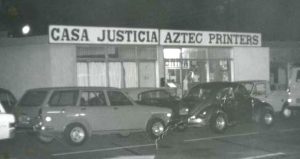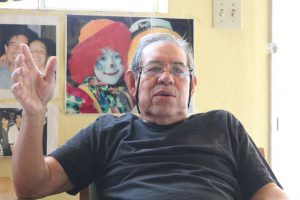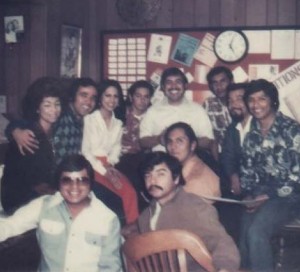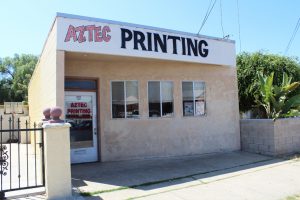After 45 years of being the home to the local Chicano Movement, Aztec Printing “The Shop” is closing its doors!

In San Diego County there are very few icons that represent the Chicano Movement of the area. Most notable is Chicano Park, on the National Registry of Historic Sites and a world-renowned symbol of the Chicano Movement. There is the Centro Cultural de la Raza. And then there is Aztec Printing — The Shop!
Chicano Park and the Centro are spaces that came about as a result of the Chicano Movement and are an important part of the history that lives on today through local cultural events. In particular Chicano Park serves as a living symbol that draws the community to this historic space to express identity and to rally for causes of importance to the Chicano and Mexican American community.
Yet there is only one place in San Diego County that is truly an iconic symbol of the Chicano Movement itself, a gathering place for Chicanos, a Chicano think-tank if you will, and that was the Aztec Print Shop originally located at 1837 Highland Avenue, National City, CA, opened in 1970, owned and operated by activist Herman Baca.

“In 1970 when I opened the original Aztec Printing on Highland Avenue, I had been unemployed for eight months and had just resigned after successfully managing Assemblyman Peter Chacon’s primary campaign win for the 79th Assembly District. I had been in the printing trade since 1963, had worked and been fired from numerous print shops in San Diego County (for trying to unionize),” recalled Baca. “In 1970 I knew nothing about owning a business, at the time I had a small printing press in my garage and after surviving economically for months I asked myself, why not go into business and open a print shop? I opened and named the shop ‘AZTEC’ because of Mexican history, and my involvement in the Chicano movement.”
In the late ‘60s and ‘70s the Chicano Movement was reaching its full potential. Chicanos were fighting for an identity and self-determination.
The grape boycott led by Cesar Chavez, was realizing the success after a decade long effort. Grape growers were meet United Farm Workers (UFW) demands and signing union contracts. The first ‘Chicano Liberation Day’ was being organized by Corky Gonzales and the Crusade for Justice. In 1969 a conference held at Santa Barbara by the Chicano Coordinating Council of Higher Education was creating a plan for curricular changes and services to Chicano students. The conference yields the formation of El Movimiento Estudiantil Chicano de Aztlan (MEChA). La Raza Unida Party emerges out of Texas. La Marcha de la Reconquista, a march from Calexico to Sacramento, begins with Rosalio Munoz, David Sanchez and the Brown Berets.
Chicanos had become the driving force behind a change for the Mexican American people.
Locally, Chicano Park was founded in 1970 when the community of Barrio Logan and Chicano movement activists with the leadership of the Chicano Park Steering Committee joined forces to protest the construction of a Highway Patrol station on the present site of the park. Centro Cultural de la Raza is a Chicano cultural center founded in 1970 by the Toltecas en Aztlán to preserve, promote and create Mexican, Chicano, and indigenous art and culture. And, in National City the Committee on Chicano Rights, (under the direction of Herman Baca), was founded at Aztec Printing.
“When Aztec Printing opened in 1970, I was the only Chicano printer in San Diego County,” stated Baca. “My intentions were to operate it as a business. However, soon after I opened ‘The Shop’, it became the hub for individuals and organizations involved in the Chicano movement in San Diego County”
Baca continued: “People today forget that when I opened ‘The Shop’, the reality for Chicanos was that they were not allowed to participate in the social, economic and political institutions of the U.S. because of discrimination and racism. Today according to the 2010 U.S. Census the Chicano/Latino population stands at 55 million and growing. In 1970 Chicanos/Latinos were a minute minority that numbered only 7 million persons! To U.S. politicians, policy makers, institutions and the majority white population, Chicanos were known simple as ’the silent, invisible and forgotten minority’.”
The first community organization to operate out of Aztec Printing was the Mexican American Political Association (MAPA) soon followed by:
• CASA Justicia (a community and immigration service center next door to Aztec Printing),
• La Raza Unida Party (a third political Party effort),
• Ad Hoc Committee on Chicano Rights (a rights confederation of 32 organizations) and,
• Committee on Chicano Rights (CCR), a membership organization organized (1976) on the principal of self-determination, dedicated to protecting the civil, constitutional, and human rights of the Chicano/Mexicano/Latino/ community.
“The reasons Chicano activists met at Aztec Printing was simple; there were few if any places for activists to meet, discuss, plan and address the numerous issues affecting the Chicano community,” stated Baca.
“The issues back then (unfortunately they still remain the same today) were police brutality, no political representation, education, immigration, employment, zoning, grape boycott, few priests, nuns, bishops in the Catholic Church, Vietnam War, youth, senior problems, etc. To address those issues Chicano activists met at Aztec Printing to organize political campaigns, demonstrations, pickets, boycotts, press conferences, develop community organizations needed to defend the community, and on Friday nights drink beer and discuss politics.

Longtime friend and member of CCR, David Avalos, describes ‘The Shop’ not only as a work place and CCR office, but as a community meeting place.
“On Friday nights in the office of the CCR men (and it was mainly men) would stop by after a week’s work to shoot the shit and talk politics. At the time I was a drinking man. I’d be there, Budweiser in hand, and on any given Friday the group might include vato locos, a municipal court judge, pintos, Federal defenders, a college MEChA president, ship yard workers, an Apostolic minister, social service workers, teachers, decorated military veterans, artists, a newspaper editor, former altar boys, and even print shop customers hoping that their jobs were ready. Sometimes, while listening to Howlin’ Wolf or Muddy Waters or John Lee Hooker from Herman’s exhaustive collection of gutbucket blues, I’d put a beer can to my lips, and lean back in my chair to finish off that last bit of brew in the corner of the can. Depending on where I was sitting, when I tilted my head back I might catch a view of framed portraits of Villa and Zapata, or of Rev. Dr. Martin Luther King, Jr. and Malcolm X, all prominently displayed on the office wall.”
It was on those nights that jokes would be told, stories shared, and friendships established. In ‘The Shop’ everyone was equal no one was better than the person sitting or standing next to them. It was there that brain storming took place, issues were discussed, and ideas originated. From those gatherings, individuals would take the ideas and share them with their circle of friends and associates. This was how the Chicano Movement grew out of ‘The Shop’.
“Those individuals learned their history at ‘The Shop’ and then went out to work and struggle in their communities. They registered people to vote, ran political campaigns, elected individuals to public offices, created newsletters, newspapers, confronted the system, demonstrated, picketed, boycotted, etcetera, continued Baca.
“The historical importance’s of Aztec Printing is that numerous Chicanas/os came out of ‘The Shop’ who then went out to change their communities. Large numbers of them went on to college, became candidates for public offices, and were elected: to school boards, city councils, CA state assembly, and senate. Many became political aides, others judges, a port commissioner, service agency directors, C.E.O.’s, and attorneys; one attorney even pleaded (and won) a landmark case before the U.S. Supreme Court,” concluded Baca.
The Chicano Movement was changing lives and the culture for the Mexican-American community. Herman Baca and CCR had grown to national prominence and Baca had gained the respect of the Chicano community, so much so, that at a statewide La Raza Unida convention Herman Baca was nominated and selected as their candidate for President of the United States!
The Chicano Movement, like all movements, to continue moving forward needs a constant push and support from the community, and for the youth to continue with the ideas and the momentum. In the 90s, as the Veterano Chicanos got older and comfortable in their jobs, that support dwindled and the young people of the community went in a different direction, leaving behind the Movement.
In 1986 after 16 years of being at 1837 Highland Avenue the building was sold and Aztec Printing, along with CCR, was moved to its present location at 710 E. 3rd Street, National City, California.
Technology catches up, leaving behind the printing press!
Part II
By Barbara Zaragoza
If the sixties and seventies marked the peak of Baca’s activist years, the next decades represented a continuation of his work, but now with a credibility and respect that could no longer be ignored.
By 1979 the San Diego Reader featured Baca on the front cover with the heading, “Some People In This Town Don’t Like Herman Baca… And He Doesn’t Care.” Three years later, he went to Washington D.C. on behalf of over 200 groups, protesting Reagan’s undocumented worker plan. Baca’s organizing skills peaked in 1975 when he gathered over 10,000 people for a march against the KKK who had announced plans to patrol the U.S.-Mexico border and deport Mexican workers.

The 1990’s, however, marked a decline in the number of people actively involved in the Chicano movement. By then, Baca explained, “many people had opportunities and they took them. So what happened was, instead of it being a “we” issue, like the Chicano movement started to try to address and solve all of the historical issues and problems, it became an “I” issue of How can I get a job?”
Although the Chicano movement may have wound down, this didn’t stop Aztec Printing from becoming a target of racism in 1995. Baca recalled that somebody telephoned and said, “I understand you Chicanos are going to take over.”
Baca said, “I don’t know where you heard that. Right now we don’t even control the block we are on.”
The man over the phone then started calling him racial names. Fifteen minutes later another individual called Baca and said, “I understand you guys are going to take over California.”
That next weekend, someone deliberately shattered the front windows of Aztec Printing. The National City Police Department reported it as a hate crime.
The definitive turning point of Baca going from gadfly to icon came in 2004 when UCSD acquired his archives. Newspapers throughout San Diego County reported that this was the first major Chicano collection acquired by the university. The documents stretched over 40 feet long and detailed 38 years of the Chicano movement in San Diego County. Baca had made sure to keep as much documentation as possible about CCR and his work, knowing one day the history would be valuable.
Meanwhile, the print shop always had a precarious existence. Baca spent more time pursuing Chicano rights than on making money. His shop also turned into a kind of two-room museum. Even after Baca gave UCSD his archives, he continued to collect boxes of paperwork as well as posters and memorabilia. Customers would enter and take the historical value of the space for granted, asking only the price for banner signs. But a history enthusiast would have seen Baca’s shop as a hidden treasure trove.
On the walls, he had a framed photo of the old Aztec print shop on Highland Avenue. Another photo displayed him sitting at a CCR meeting with local Chi-cano activists Rodolfo “Corky” Gonzales, Bert Corona and Albert Garcia, among others. Images of Cesar Chavez were peppered throughout the shop, including a framed article about Chavez’s death. Baca, of course, displayed many pictures of his wife, Nadine, and his children. His family has always been important.
Aztec Printing naturally featured several posters of Aztec gods. You could also find images of Pancho Villa, Emiliano Zapata and Ricardo Flores Magon—all prominent figures from the 1910 Mexican Revolution. Baca has always loved history. During the heyday of the Chicano movement, he searched for any sort of book about Mexico and Mexican-Americans. There was very little written, but he found a 1968 copy of North from Mexico by Carey McWilliams.
Baca said, “I kept looking and looking and found very little until I got to the 1910 Mexican Revolution. That’s when I started reading and saw, these guys are saying the same things that we’re saying, but it’s a different era.”
In the backroom, Baca kept two offset printers in pristine working condition: an AB Dick 385 and an AB Dick 9810. He bought both sometime around the 1980’s, a time when professionals needed extensive training to work the machines.
“Technology and time have dictated that Aztec Printing close its doors,” Baca said. “When I started, a new process called offset printing, which is what those printers are, came into being and replaced letterpress. A lot of individuals got knocked out of that process and this new process took over. And now the wheels have made a turn and technology, the digital age, has done away with offset printing.”

Baca continued to print CCR newsletters up until 2014, each copy visually elegant. Baca doesn’t see the closing of Aztec Printing as the end of his work in the Chicano movement. He explained, “As long as there are problems, there is always a movement.”
His immediate future plans are to work on the UCSD archives. “I want to re-examine and re-familiarize myself with the documentation in the archives. Then place the organizations, issues and persons in historical chronological order, and provide historical definition to the documentation.”
Baca leased the property from owner Milan Kaiser who said the space hasn’t been rented yet. Kaiser is not opposed to designating the property as a historic site. The question remains whether any community activism still exists so that the shop can be preserved the way UCSD has preserved the archives.
Baca officially closes the doors of Aztec Printing on January 31st after 45 years in operation.





